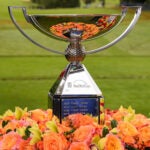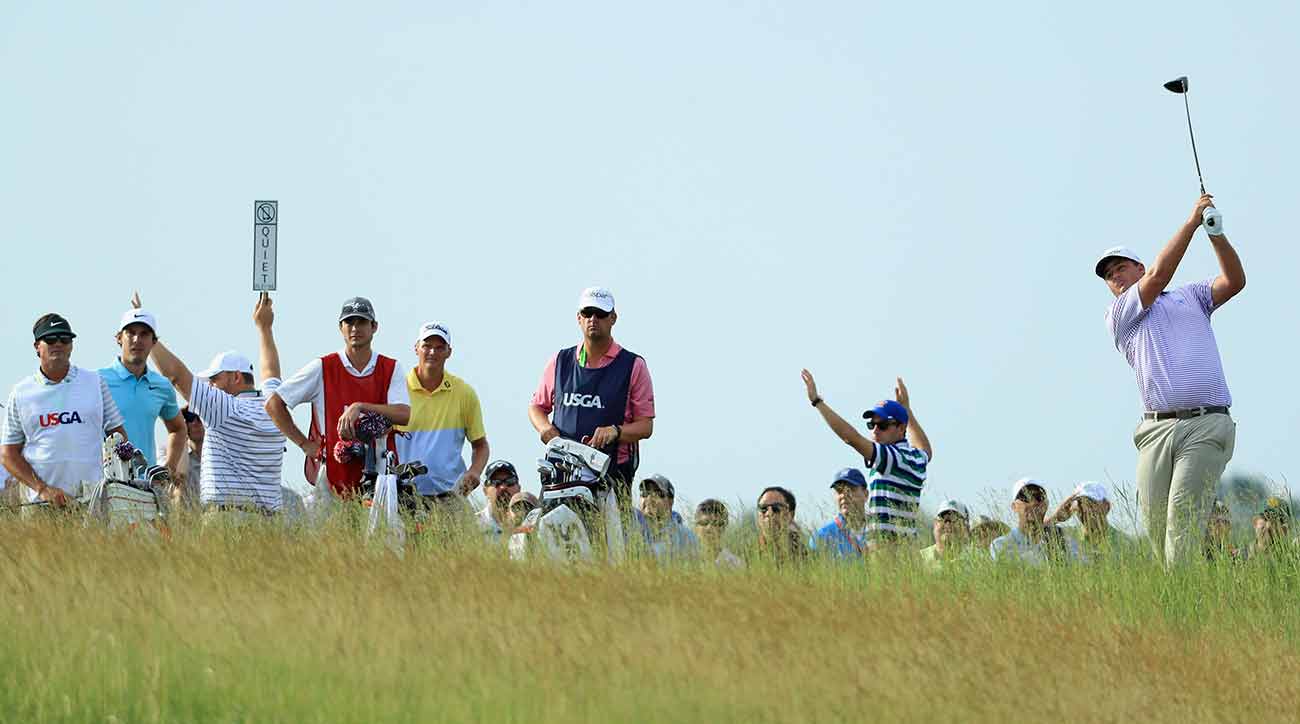SOUTHAMPTON, N.Y. — My wife and I, through the happenstance of life and the kindness of friends, are staying this week in a cozy house on a quiet street in the heart of the village here, just a few miles from the bedlam of Shinnecock Hills. We share a driveway and a backyard with our neighbors, a journeyman golfer named Michael Putnam and his family. They came here via the magnet of golf, too. Monday night, when I met Michael on our lawn, damp with evening dew, I asked him if he had played in other U.S. Opens. “This is my sixth,” he said. You could hear the earned pride. How many people in this world have played in six U.S. Opens?
There’s been a lot of focus this week on Phil (career grand slam) and Tiger (comeback trail) and Dustin (world domination). But more than any other golf event, our national championship is a vigorous nod to those grinding out a living in this game, getting your message out not via Twitter but with your clubs. The fact is playing in six U.S. Opens is an incredible achievement. There is no Dustin Johnson without a thousand Michael Putnams. You can’t achieve status in a vacuum. Someone must prop up our heroes.
Michael’s brother Joel doubles as his caddie. He was in the house, too. Another brother, Andrew, plays the PGA Tour, and last week, at the Memphis stop, Andrew was tied with Dustin Johnson through 54 holes. (He was not in the Shinnecock field or in the house.) Michael’s wife, Kristina, who typically stays home in Seattle with their three children when her husband plays, flew in for the Open. One night she was doing flips on a backyard trampoline. Their three kids were home, being watched by the two grandmothers. Are you rooting for Michael Putnam yet? If not, check your pulse.
[image:14161218]
Through the week — these Open weeks sometimes go slow but this one has been a blur — I’ve seen the Putnam entourage walking too and from town, often with Starbucks in hand. It’s the Seattle influence. The Putnams live right near Chambers Bay. (Michael played in the 2015 Open there.) Later in the week, Michael’s father, Dan, arrived. Dan is working on a hotel development near the Chambers Bay course. He’s eager to see how the Chambers Bay grass comes in.
We’ve all been eating at the same Italian restaurant (La Parmigiana), shopping at the same grocery store (Citarella) and taking the same route to work, although I park in the grass field behind the Elks Lodge and he parks on the dusty gravel of the player parking lot. Wherever I’ve seen him, off-course or on, this Michael Putnam never looks rushed. He is mellow. Mellow and casual. He’s a giant of a man — built like an offensive lineman, circa 1960 — and he’s been walking around town in shorts and flip-flops, with his baseball cap backward. You’d never know he’s playing in the Open, although the pale left hand hints at his profession.
When I asked him about the course, he said, “It’s hard.” Giving me a verbal highlight package after his first-round 78, he said, “I played with the guy who shot 92.” His USGA-issued Lexus courtesy car was on our pebbled driveway. His Srixon Tour bag — stuffed with elegant blade irons, no-glare Cleveland wedges and a putter whose head was shrouded in a U.S. Open headcover — was in the back of the truck. In the player lockerroom — a luxurious tent erected for the occasion — Michael’s neighbors were an established Ryder Cup star (Ian Poulter) and a future one (Jon Rahm).

In the tent next to it — Player Hospitality — was all the free food you could possibly want. It all sounds glamorous and it is, until you rise in the dark for your 6:56 a.m. tee time and soon after you find yourself trying to make a four-footer for bogey in a 20-knot wind. The USGA has been conducting this thing since 1895, there have been 118 of them in all, and Michael, three-time winner on the Web.com tour, has played in a half-dozen. He was trying to make his fourth Open cut.
Late Friday morning, Michael was on the range, Jhonny Vegas beside him, brother Joel behind him. The rain clouds were clearing out and the wind was coming up. A hand injury has limited and hampered Michael’s play for the past year or so and his Web.com status is only conditional. (Andrew, meanwhile, has pretty much secured his PGA Tour status for next year.) Michael has had to weaken his grip as a result of his injury, and he is adjusting to a different ball flight because of it. The things we don’t know. It’s amazing, how the happenstance of life can change your interests, rooting and biographical. Michael turned 35 on June 1.
He talks golf regularly with the Tour player Jim Herman, a close friend, and all his brothers. Joel is the oldest, then Michael, followed by Andrew. The youngest of the four Putnam children, Nathan, was an accomplished Washington State schoolboy golfer at Life Christian Academy but is not playing in college. Jim happens to be a buddy of mine, and he and Michael met years ago when they were on the same flight to Panama, for a Web.com event. Jim’s wife, Carolyn, was on the flight, too. “I didn’t know who they were,” Michael told me. “Then I see Carolyn writing in her diary, ‘We’re flying to Panama for our fist Web.com event!’ And I’m thinking, ‘Wait ‘till you see Panama.'” Between the airport and the golf course, you drive through some third-world poverty.
As he came off the driving range Friday afternoon, I found myself saying something I normally never would: “You can make this cut!”
“I know,” he said. He looked, I would say, confident. He looked like a ballplayer.
He played a lot of good golf on Friday afternoon. He liked the course, which he said had Pinehurst greens, Oakmont rough and Erin Hills terrain. He’s played in one British Open, at Carnoustie, but he doesn’t think you can compare Shinnecock Hills with Carnoustie, where the Open will be held next month. No burns, much less bounce. He figured if he could shoot a second-round even par he’d have a good chance of making the cut.

He went out in 36, one over, and he was fighting the good fight. But he really needed to make a birdie before he made his second bogey, and that didn’t happen. He came home in 40 for 76, one better than Jon Rahm. A 78 and a 76. Still, better than not playing in it at all. His sixth U.S. Open.
Late Friday night, Golf Channel was on in his living room TV. Everybody was asleep except for Michael and his father. We watched a highlight tape that showed Woods watching Johnson make a second-round bomb. “Tiger looks like, ‘Those are the putts I used to make.'” Exactly.
Michael has never played with Woods, but he has played with Johnson, in a college tournament. Michael played at Pepperdine and Johnson for Coastal Carolina. They were paired together for a 36-hole day. Johnson was keeping Michael’s card. You had to turn in a card after the first 18. They exchanged cards but the one Johnson was supposed to fill was completely blank. Michael could not recall all his scores and hurriedly signed for a 76 instead of the 77 he had shot. “The only time I’ve ever been DQed,” he said. He was laughing. In Memphis, Johnson was hitting it half a football field past Andrew Putnam. Still, he made $712,000 for finishing second. Michael Putnam got paid $10,000 for his two rounds at Shinnecock Hills.
Early Saturday morning, the Putnam clan was starting its long trip back to Seattle. Michael has a Starbucks in hand. He had been on the road for five weeks and was ready to get off it. I saw him and Joel in the driveway, packing up the bag. They had to make a stop at Shinnecock Hills, for a 2-iron that was left behind.
“It was on top of your locker,” Joel said.
The 2-iron had come out for the second round in exchange for another club.
“There was nothing on top of that locker,” he said.
They say when you leave something behind it means you didn’t really want to leave. Of course, exhaustion could explain it, too. In any event, from this week on, when this Michael Putnam is playing, I’ll be rooting for him. This game is loaded with happenstance.
Michael Bamberger may be reached at mbamberger0224@aol.com.






